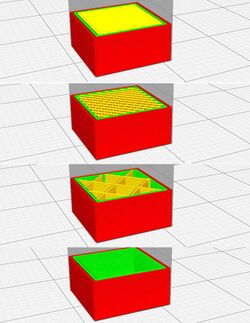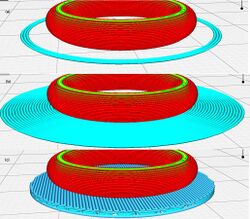Engineering:Slicer (3D printing)
A slicer is a toolpath generation software used in 3D printing. It facilitates the conversion of a 3D object model to specific instructions for the printer. The slicer converts a model in STL (Stereolithography) format into printer commands in G-code format. This is particularly useful in fused filament fabrication and other related 3D printing processes.[1][2][3][4][5]
Features of Slicers
A slicer initially segments the object as a stack of flat layers. It then describes these layers through linear movements of the 3D printer's extruder, the fixation laser, or an equivalent component.[6] All these movements, together with some specific printer commands like the ones to control the extruder temperature or bed temperature, are ultimately compiled in the G-code file. This file can then be transferred to the printer for execution.
Slicers may have additional features, such as:

- Infill: Printing solid objects requires a significant amount of material (such as filament) and time. To mitigate this, slicers can automatically convert solid volumes to hollow ones, thereby saving costs and reducing print time. These hollow objects can be reinforced with internal structures, like internal walls, to enhance robustness. The proportion of these structures, known as 'infill density', is a key parameter that can be adjusted in the slicer..

- Supports: Since most 3D printing processes build objects layer by layer, from the bottom up, each new layer is deposited directly on top of the previous one. Consequently, every part of the object must, to some extent, rest on another part. For layers that are 'floating'—for example, the flat roof of a house or a horizontally extended arm in a figure—the slicer can automatically add supports. These supports are designed to touch the object in a manner that allows for easy detachment upon the completion of the object's production..

- Rafts, skirts and brims: The printing of the first object layer, which contacts the printer bed, presents unique challenges, such as adherence issues, surface rugosity, and the smooth deposition of the initial filament.[7] To mitigate these problems, the slicer can automatically add detachable structures. Common types of these base structures include: [8]
- A skirt: A single band encircling the object's base, without touching it.
- A brim: Multiple lines of filament around the base of the object, touching but not underneath it, and extending outward.
- A rafts: Several layers of material forming a detachable base on which the object is printed.
List of slicer software
There is a diverse array of slicer applications available, including many that are free and open-source. Some of the most commonly used ones include:[4][9]
| Name | License | Relations |
|---|---|---|
| CraftWare Pro | Proprietary | |
| Ultimaker Cura | GNU LGPL | |
| SuperSlicer | GNU AGPL | Fork of PrusaSlicer |
| OrcaSlicer | GNU AGPL | Fork of BambuStudio |
| BambuStudio | GNU AGPL | Fork of PrusaSlicer |
| PrusaSlicer | GNU AGPL | Fork of Slic3r |
| Slic3r | GNU AGPL | |
| Eiger | Proprietary | |
| Simplify3D | Proprietary | |
| FlashPrint | Proprietary | |
| KISSlicer | Proprietary | |
| IdeaMaker | Proprietary | |
| REALvision | Proprietary | |
| Voxelizer | Proprietary | |
| NanoDLP | Proprietary | |
| ChopChop3D | Proprietary | |
| Kiri:Moto | MIT |
References
- ↑ Evans, Brian (25 September 2012). Practical 3D Printers: The Science and Art of 3D Printing. apress. ISBN 978-1-4302-4393-9.
- ↑ Keon Aristech Boozarjomehri (28 April 2016). 3D Printing at School and Makerspaces: Project Learning with 3D Printing. Cavendish Square. ISBN 978-1-6804-5016-3.
- ↑ Liza Wallach Kloski, Nick Kloski (2016). Getting Started with 3D Printing: A Hands-on Guide to the Hardware, Software, and Services Behind the New Manufacturing Revolution. Maker Media, Inc. ISBN 978-1-6804-5020-0.
- ↑ 4.0 4.1 "Slicer - RepRap" (in en). https://reprap.org/wiki/Slicer.
- ↑ "What is Slicing Software, and what does it do?" (in en). https://www.goprint3d.co.uk/blog/what-is-slicing-software-and-what-does-it-do/.
- ↑ "The Best Slicer Software For All Levels" (in en-US). 2023-10-29. https://www.3dsourced.com/.
- ↑ "When should I use a raft, when should I use a brim?". https://3dprinting.stackexchange.com/questions/65/when-should-i-use-a-raft-when-should-i-use-a-brim.
- ↑ "Rafts, Skirts and Brims!" (in en-US). https://www.simplify3d.com/support/articles/rafts-skirts-and-brims/.
- ↑ "Best 3D Slicer Software for 3D Printers of 2018 (Most are Free) | All3DP" (in en-US). All3DP. 2018-06-01. https://all3dp.com/1/best-3d-slicer-software-3d-printer/.
 |

